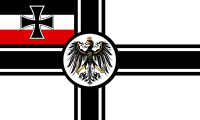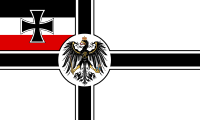
Back البحرية الإمبراطورية الألمانية Arabic Almaniya İmperatorluq Donanması Azerbaijani Koasaliche Marine (Begriffsklearung) BAR Германскі імперскі флот Byelorussian Кайзерлихе Марине Bulgarian Kaiserliche Marine Breton Kaiserliche Marine Catalan Kaiserliche Marine Czech Kaiserliche Marine Danish Kaiserliche Marine German
| Imperial Navy Kaiserliche Marine | |
|---|---|
 Major elements of the High Seas Fleet in the early 1910s | |
| Active | 1871–1918 |
| Country | |
| Branch | Navy |
| Colors | Black, white and red |
| March | "Gruß an Kiel" |
| Engagements | |
| Commanders | |
| Commander-in-chief | German Emperor |
| Governing body | Imperial Admiralty (1872–1889) High Command (1889–1899) Imperial Naval Office (1889–1918) Imperial Naval Cabinet (1889–1918) Imperial Admiralty Staff (1899–1918) |
| Insignia | |
| War ensign (1903–1918) |  |
| War ensign (1892–1903) |  |
| War ensign (1871–1892) |  |
| Naval jack (1903–1918) |  |
The Imperial German Navy or the Kaiserliche Marine (Imperial Navy) was the navy of the German Empire, which existed between 1871 and 1919. It grew out of the small Prussian Navy (from 1867 the North German Federal Navy), which was mainly for coast defence. Kaiser Wilhelm II greatly expanded the navy. The key leader was Admiral Alfred von Tirpitz, who greatly expanded the size and quality of the navy, while adopting the sea power theories of American strategist Alfred Thayer Mahan. The result was a naval arms race with Britain, as the German navy grew to become one of the greatest maritime forces in the world, second only to the Royal Navy.
The German surface navy proved ineffective during the First World War; its only major engagement, the Battle of Jutland, was a draw, but it kept the surface fleet largely in port for the rest of the war.[1] The submarine fleet was greatly expanded and threatened the British supply system during the U-boat campaign. As part of the Armistice, the Imperial Navy's main ships were ordered to be turned over to the Allies but they were instead scuttled by their own crews. All ships of the Imperial Navy bore the title SMS, for Seiner Majestät Schiff (His Majesty's Ship).
- ^ Geoffrey Bennett (June 1960), "The Battle of Jutland", History Today 10#6 pp. 395–405.
© MMXXIII Rich X Search. We shall prevail. All rights reserved. Rich X Search